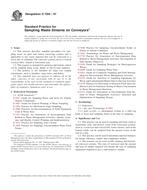Potřebujeme váš souhlas k využití jednotlivých dat, aby se vám mimo jiné mohly ukazovat informace týkající se vašich zájmů. Souhlas udělíte kliknutím na tlačítko „OK“.
ASTM D7204-07
Standard Practice for Sampling Waste Streams on Conveyors
Automaticky přeložený název:
Standardní praxe pro odběr vzorků z toků odpadů na dopravnících
NORMA vydána dne 15.2.2007
Informace o normě:
Označení normy: ASTM D7204-07
Poznámka: NEPLATNÁ
Datum vydání normy: 15.2.2007
Kód zboží: NS-37856
Počet stran: 3
Přibližná hmotnost: 9 g (0.02 liber)
Země: Americká technická norma
Kategorie: Technické normy ASTM
Anotace textu normy ASTM D7204-07 :
Keywords:
conveyor, incinerator, kiln, lifts, sampling, soil, waste streams, ICS Number Code 13.030.40 (Installations and equipment for waste disposal and treatment)
Doplňující informace
| Significance and Use | ||||||||||||||||||||||||||||||||
|
This practice can be used in sampling ash from a kiln or incinerator, soils, and process waste from conveying systems, such as, a conveyer and vertical lifts. Some slurries, such as the bottom solids, can be sampled from the quench waters at the end of a kiln. This practice can be used to determine material balances for burner efficiency studies and compliance studies. This practice can be used on lifts, sloping, and horizontal conveyor systems. The type of conveyor and the amount and type of sample required will dictate the type of sampling equipment required to get a representative sample. The sample is taken directly from the conveyor before emptying into the waste container or pile for disposal or recycling using a scoop, dipper, or shovel depending upon the sample requirements (see Practice D 5633). The sample is then put into the sample container for analysis. The place, quantity, frequency, and time of sampling is dependent upon the conveying system equipment, DQOs (Practice D 5792), work or sampling plan (See Practice D 5283 and Guide D 4687), and analysis to be run. 4.5.1 Large particles can be mechanically excluded on a belt system. Large particles may accumulate at the bottom of an inclined/sloped belt system. Therefore, steps, if possible, need to be taken so that particles of all sizes have equal chances of being sampled. 4.5.2 The number of samples and sample time is dependent upon the system, the precision required, the decisions that are to be made, the cost, and the degree of heterogeneity of the material (see Guide D 5956, Practice D 6250, and Guide D 6311). 4.5.3 In general, the ideal sampling location is nearest to the point of generation since temperature, oxidation, and air movement may change some samples with time. The practice does not address issues related to the heterogeneity of the sample. |
||||||||||||||||||||||||||||||||
| 1. Scope | ||||||||||||||||||||||||||||||||
|
1.1 This practice describes standard procedures for sampling waste on open and closed conveying systems and is applicable to any waste material that can be conveyed to a waste pile or container. The conveyor system can be a vertical (vertical lifts), sloped or horizontal type. 1.2 This practice is intended for particles and slurries, which can be sampled using scoop, dipper or shovel type samplers. 1.3 The practice is not intended for large size sample constituents, such as boulders, large rocks, and debris. 1.4 This standard does not purport to address all of the safety concerns, if any, associated with its use. It is the responsibility of the user of this standard to establish appropriate safety and health practices and determine the applicability of regulatory limitations prior to use. |
||||||||||||||||||||||||||||||||
| 2. Referenced Documents | ||||||||||||||||||||||||||||||||
|
Doporučujeme:
Aktualizace technických norem
Chcete mít jistotu, že používáte pouze platné technické normy?
Nabízíme Vám řešení, které Vám zajistí měsíční přehled o aktuálnosti norem, které používáte.
Chcete vědět více informací? Podívejte se na tuto stránku.




 Cookies
Cookies
